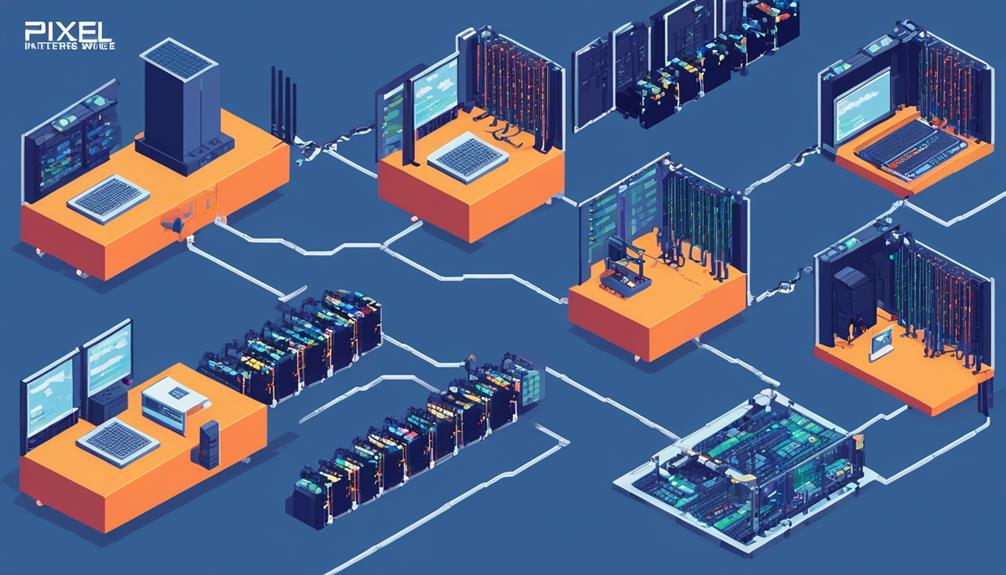Networking hardware for cloud systems is a critical component that businesses need to consider when moving their operations to the cloud. As organizations increasingly rely on the cloud for their infrastructure and application needs, the right networking hardware becomes essential for ensuring seamless connectivity, security, and performance.
However, with a multitude of options available, selecting the right networking hardware can be challenging. In this discussion, we will explore the benefits of cloud networking hardware, delve into the key components and types of networking hardware for cloud systems, and discuss considerations and best practices for deploying and managing this crucial infrastructure.
By the end, you will gain a comprehensive understanding of the importance of networking hardware in cloud systems and be better equipped to make informed decisions for your organization's cloud networking strategy.
Key Takeaways
- Cloud networking hardware is essential for enabling scalability, agility, and faster time-to-market in cloud systems.
- It provides seamless connectivity, security, and performance, allowing for efficient deployment, management, and scaling of applications and infrastructure.
- Networking hardware plays a crucial role in implementing multicloud networking strategies and ensuring compatibility with virtualized environments.
- Key components of cloud networking hardware include network switches, routers, load balancers, firewalls, and intrusion detection systems, which collectively optimize network performance, security, and scalability.
Benefits of Cloud Networking Hardware

Cloud networking hardware offers businesses scalability, agility, and time-to-market acceleration, addressing infrastructure needs, regional expansions, and redundancy plans while unifying a hyper-distributed world. With the increasing adoption of cloud networking applications, businesses require efficient and reliable cloud network components to support their operations. Networking hardware and software play a crucial role in providing the necessary connectivity, security, and visibility for workloads in both on-premises and cloud environments.
One of the key benefits of cloud networking hardware is its ability to enable the deployment, management, scaling, and security of applications and infrastructure. Modern enterprises rely on cloud networking solutions to ensure consistent connectivity and seamless integration between different components of their network. By leveraging network management software, businesses can easily monitor and control their cloud networking infrastructure, ensuring optimal performance and minimizing downtime.
Moreover, cloud networking hardware supports multicloud networking strategies, which offer advanced capabilities such as application and workload-awareness, SaaS-delivered control plane, and integration with public cloud providers. This allows businesses to leverage multiple cloud platforms simultaneously, optimizing their resources and achieving greater flexibility and scalability.
Another advantage of cloud networking hardware is its compatibility with virtualized environments. By combining networking hardware with virtualization technologies, businesses can create virtual networks that are highly flexible and efficient. This enables them to quickly adapt to changing business needs and easily scale their network infrastructure.
Understanding Cloud Networking Infrastructure
To gain a comprehensive understanding of cloud networking infrastructure, it is essential to recognize its pivotal role in empowering modern enterprises to build and deliver applications while addressing infrastructure needs, regional expansions, and redundancy plans. Businesses turn to the cloud for agility, differentiation, time-to-market acceleration, and scalability. Cloud networking plays a crucial role in addressing these requirements and providing the necessary resources for organizations to thrive in a highly competitive landscape.
Cloud networking encompasses the management of networking resources within the cloud environment. Many organizations adopt a multi-data center strategy and leverage multiple clouds from different cloud service providers. This approach allows them to distribute workloads, ensure high availability, and improve performance. Cloud networking enables seamless connectivity between these different cloud environments, ensuring efficient data transfer and communication.
In addition to managing connectivity between different cloud environments, cloud networking infrastructure also involves managing the network resources within a single cloud environment. This includes virtual networks, subnets, load balancers, firewalls, and other network-related components. Cloud networking providers offer a range of services to facilitate the management of these resources, allowing enterprises to customize their network infrastructure according to their specific needs.
Furthermore, cloud networking infrastructure enables organizations to scale their applications as their business demands fluctuate. By leveraging the elasticity of the cloud, enterprises can dynamically allocate and deallocate networking resources, ensuring optimal performance and cost efficiency. This flexibility allows organizations to respond quickly to changing market conditions and customer demands.
Importance of Networking Hardware in Cloud Systems

The importance of networking hardware in cloud systems cannot be overstated.
Network performance optimization is crucial for ensuring efficient data transmission and minimizing latency in cloud environments.
Scalability and flexibility are also vital, as networking hardware must be able to adapt to the changing needs and demands of a cloud system.
Network Performance Optimization
Networking hardware plays a crucial role in optimizing network performance in cloud systems, ensuring efficient and secure delivery of applications in the modern enterprise environment. To achieve network performance optimization in cloud systems, the following strategies and elements are essential:
- Bandwidth management: Networking hardware helps manage and allocate sufficient bandwidth to handle the increasing volume of data traffic in cloud systems, ensuring smooth application delivery.
- Network latency reduction: By utilizing advanced networking hardware, cloud systems can minimize network latency, improving the responsiveness of applications and enhancing user experience.
- Network security: Networking hardware enables the implementation of robust security measures, such as firewalls and intrusion detection systems, to protect sensitive data and prevent unauthorized access in cloud systems.
- Network scalability: Cloud systems require networking hardware that can scale to accommodate the growing demands of data and users, allowing for seamless expansion and resource allocation.
Scalability and Flexibility
Scalability and flexibility are imperative in cloud networking, as they allow businesses and applications to adapt to changing demands and ensure seamless resource allocation. In order to achieve this, networking hardware in cloud systems must support a scalable and flexible infrastructure.
Cloud providers and businesses rely on the ability to expand and contract network resources on demand to meet changing needs and accommodate growth. This is particularly important in private cloud networks, where the network infrastructure needs to be agile and responsive.
Software-defined networking (SDN) plays a crucial role in enabling scalability and flexibility in cloud networking. SDN allows for the centralized control and programmability of network resources, making it easier to dynamically adjust network configurations and support the changing needs of cloud-based applications and services.
Key Components of Cloud Networking Hardware
When considering the key components of cloud networking hardware, it is important to focus on the hardware requirements for cloud networking and the top networking vendors for cloud systems.
Understanding the hardware requirements is crucial in order to ensure optimal performance and scalability of the cloud network.
Additionally, exploring the top networking vendors can provide insights into the most reliable and efficient solutions available in the market.
Hardware Requirements for Cloud Networking
To ensure optimal performance and efficient data transfer in cloud systems, it is imperative to have a robust and well-configured set of hardware components specifically designed for cloud networking. Here are the key components of hardware that are essential for cloud-based networking in a private or public cloud computing environment:
- Network Switches: These devices connect multiple devices within a network, enabling data exchange and communication.
- Routers: Routers direct network traffic, ensuring data packets are forwarded to their intended destinations efficiently.
- Firewalls: Firewalls protect the network from unauthorized access and potential security threats.
- Load Balancers: Load balancers distribute network traffic evenly across multiple servers, optimizing resource utilization and preventing bottlenecks.
These components work together to create a reliable and scalable network infrastructure, facilitating seamless communication and data transfer within a cloud environment.
It is crucial to invest in high-quality networking equipment to achieve optimal performance and ensure the smooth operation of cloud systems.
Top Networking Vendors for Cloud Systems
Cisco, Juniper Networks, Arista Networks, HPE, and VMware are among the top networking vendors for cloud systems, providing key components of cloud networking hardware.
These vendors offer a range of solutions for cloud networking, including virtual routers, virtual networks, and virtual machines. They also provide network management resources and network capabilities to ensure efficient and secure cloud operations.
Cisco, for example, offers products like NSX Data Center and network and security virtualization platforms, while Juniper Networks provides NSX Distributed Firewall for cloud networking. Arista Networks, HPE, and VMware also offer innovative solutions that enable organizations to achieve agility, security, and efficiency in their cloud networking.
These top networking vendors play a crucial role in meeting the networking requirements of modern enterprises and supporting their cloud infrastructure.
Types of Networking Hardware for Cloud Systems

Cloud systems rely on various types of networking hardware to ensure efficient and reliable connectivity for seamless data transmission and application delivery. The following types of networking hardware are commonly used in cloud systems:
- Switches: Switches play a crucial role in cloud networks by connecting network devices and facilitating the flow of data between them. They are responsible for forwarding data packets to the appropriate destination, ensuring efficient communication between network resources.
- Routers: Routers are essential components in cloud systems as they enable connectivity between different networks. They use routing tables to determine the best path for data packets to travel, ensuring that they reach their intended destinations. In cloud environments, virtual routers are often used to provide flexibility and scalability.
- Load Balancers: Load balancers distribute network traffic evenly across multiple servers or resources, optimizing performance and preventing any single resource from being overwhelmed. In cloud systems with multiple clouds or data centers, load balancers play a critical role in ensuring high availability and efficient resource utilization.
- Firewalls: Security is paramount in cloud systems, and firewalls are fundamental for protecting network resources from unauthorized access and potential threats. Firewalls monitor and control incoming and outgoing network traffic based on predefined security rules, helping to safeguard sensitive data and ensure compliance with regulations.
Scalability and Flexibility in Cloud Networking Hardware
Scalability and flexibility are crucial considerations in the realm of cloud networking hardware, allowing businesses to seamlessly adapt and grow while maintaining optimal performance and resilience. Cloud networking hardware enables organizations to quickly respond to changing demands and accommodate growth without the need for extensive infrastructure overhauls. This agility is essential in today's fast-paced business environment.
With scalable and flexible cloud networking hardware, businesses can easily expand their regional presence and implement redundancy plans. This enhances resilience and performance by ensuring that applications and services remain accessible even in the event of disruptions or failures. Furthermore, the ability to leverage multiple clouds from different providers with scalable networking hardware empowers organizations to meet diverse application and infrastructure needs.
In the modern enterprise landscape, scalable and flexible cloud networking hardware is essential for efficient application building and delivery. It allows businesses to rapidly scale their resources up or down as required, enabling agility and ensuring a competitive advantage. Additionally, cloud networking hardware plays a vital role in unifying a hyper-distributed world. It provides consistent connectivity, security, and visibility for workloads across various environments, including on-premises infrastructure, private clouds, and public clouds.
To achieve scalability and flexibility, virtual and software-defined networking technologies are often employed. These technologies decouple networking functions from physical hardware, allowing for greater agility and adaptability. By abstracting networking functions into software, organizations can dynamically allocate resources, provision new services, and optimize network traffic flow.
Security Features of Cloud Networking Hardware

Security features of cloud networking hardware play a crucial role in safeguarding network infrastructure and data. Encryption techniques are employed to protect sensitive information during transmission, ensuring its confidentiality and integrity.
Access control mechanisms, such as authentication and authorization, are implemented to prevent unauthorized access and maintain the privacy of resources.
Encryption for Data Protection
Encryption is an essential security feature of cloud networking hardware, ensuring the protection of sensitive data by transforming it into an unreadable format.
Here are four key points about encryption for data protection in cloud networking hardware:
- Safeguarding Data: Encryption plays a crucial role in securing data both in transit and at rest within the cloud network. By encrypting data, it becomes unintelligible to unauthorized individuals, minimizing the risk of data breaches.
- Advanced Encryption Standards (AES): Cloud networking hardware commonly employs advanced encryption standards like AES to enhance data security. AES is a symmetric encryption algorithm widely recognized for its strength and efficiency.
- Encryption Key Management: Effective encryption key management is vital for maintaining the integrity and confidentiality of encrypted data. Properly managing encryption keys ensures that only authorized individuals can access and decrypt the protected information.
- Comprehensive Data Protection: By leveraging encryption in cloud networking hardware, organizations can provide comprehensive data protection, bolstering the security of their services and safeguarding sensitive information from potential threats.
Access Control and Authentication
Access Control and Authentication are critical features of cloud networking hardware. These security measures are crucial for safeguarding sensitive data and preventing unauthorized access to the network.
Access Control and Authentication mechanisms can include multi-factor authentication, role-based access control, and encryption to secure network traffic and user interactions. By implementing strong Access Control and Authentication, organizations can mitigate the risk of unauthorized access, data breaches, and other security threats.
These security features are essential for maintaining the trust and integrity of cloud networking environments, protecting against potential cyber threats and unauthorized intrusions. Networking hardware, such as virtual routers, plays a vital role in enforcing access control policies and authenticating users and devices within the network segment.
Performance Optimization With Cloud Networking Hardware
Maximizing data transfer speeds, reducing latency, and ensuring efficient resource allocation are essential goals in the performance optimization of cloud networking hardware. To achieve these goals, organizations need to employ high-performance network hardware like switches, routers, and load balancers.
Here are four key ways in which performance optimization can be achieved with cloud networking hardware:
- Utilizing advanced network hardware: High-performance network hardware is crucial for achieving optimal cloud networking. It can enhance security, improve data throughput, and enable seamless scaling of cloud infrastructure. Organizations should invest in advanced hardware that offers features like high-speed connectivity, low-latency switching, and efficient packet processing.
- Optimizing network design: A well-designed network architecture is essential for maximizing performance. By carefully planning the placement of networking hardware and optimizing network paths, organizations can minimize latency and improve data transfer speeds. This includes considering factors like the location of public cloud services, on-premises data centers, and virtual routers.
- Leveraging specialized hardware: Specialized hardware can significantly improve performance in cloud networking. For tasks like packet processing and traffic management, organizations can benefit from using purpose-built hardware solutions. These specialized devices are designed to handle high volumes of network traffic efficiently, resulting in improved performance and reduced latency.
- Prioritizing applications and resources: Different applications and resources have varying performance requirements. By prioritizing critical applications and allocating resources accordingly, organizations can ensure that the most important workloads receive the necessary network resources. This can be achieved through techniques like Quality of Service (QoS) mechanisms and traffic shaping.
Integration of Networking Hardware in Cloud Environments

To ensure seamless connectivity and security for applications and data across multiple clouds and on-premises environments, the integration of networking hardware in cloud environments is essential. Cloud networking hardware plays a critical role in supporting virtualization, cloud migration, and elasticity to accommodate dynamic workloads and changing infrastructure needs.
One of the key components of building a secure and scalable cloud networking infrastructure is the use of network virtualization platforms. Platforms like NSX Data Center and NSX Distributed Firewall provide the necessary tools for creating virtual routers and managing network resources. These platforms enable cloud service providers and organizations to configure, maintain, and protect their networks while enabling agile application deployment.
The integration of networking hardware becomes particularly crucial in hybrid cloud environments where organizations combine their on-premises infrastructure with public cloud services. In such scenarios, physical and virtual networking hardware must seamlessly work together to ensure connectivity and security across both environments.
The responsibilities for managing and integrating networking hardware in cloud environments involve coordination among various teams, including NetOps, SecOps, DevOps, and cloud architects. These teams collaborate to configure and maintain the networking infrastructure and ensure that it meets the organization's security and performance requirements.
A successful multicloud networking strategy requires an architectural approach that prioritizes application and workload management, access assurance, simplification, and cost reduction. Organizations must carefully evaluate their networking hardware options and choose solutions that align with their specific requirements, whether it's a public cloud provider's native networking capabilities or third-party solutions that offer enhanced features and flexibility.
Considerations for Choosing Networking Hardware for Cloud Systems
The selection of networking hardware for cloud systems requires careful consideration of scalability, compatibility, security, monitoring capabilities, and configuration flexibility.
Here are some key factors to consider when choosing networking hardware for cloud systems:
- Scalability: Cloud systems are known for their dynamic nature, with workloads that can scale up or down rapidly. It is important to choose networking hardware that can handle the scalability demands of cloud systems, such as virtual routers that can easily scale to accommodate increased traffic.
- Compatibility: Cloud environments often involve multi-data center strategies and the integration of multiple cloud service providers. Networking hardware should be compatible with these strategies and providers to ensure seamless connectivity and efficient data transfer between different cloud environments.
- Security Features: Security is a top concern in cloud systems. Look for networking hardware that offers robust security features, such as built-in firewalls, intrusion detection systems, and encryption capabilities. These features will help protect applications and data in the cloud from unauthorized access and malicious attacks.
- Monitoring Capabilities: Effective monitoring is crucial for optimizing the performance and ensuring the availability of cloud systems. Choose networking hardware that provides comprehensive monitoring capabilities, allowing you to track network traffic, identify bottlenecks, and troubleshoot issues promptly. This will help maintain the overall health and performance of the cloud infrastructure.
In addition to these considerations, it is important to evaluate the flexibility and ease of configuration of the networking hardware, particularly for hybrid and multicloud networking architectures. The hardware should support the seamless integration of different physical types of cloud, and enable efficient management of IP addresses and other network resources.
Best Practices for Deploying and Managing Cloud Networking Hardware

Implementing network virtualization is a key best practice for deploying and managing cloud networking hardware. Network virtualization allows for the creation of virtual networks that are decoupled from the physical infrastructure, providing flexibility and scalability. This enables the allocation of virtual routers and switches to different tenants or applications, allowing for efficient use of management resources.
When deploying cloud networking hardware, it is important to consider the specific use cases and types of cloud environments. Public, private, and hybrid clouds have different requirements and configurations. For example, in a public cloud, network security must be a priority, and configuring ports, firewalls, and access control lists is essential to ensure a secure cloud networking environment.
Regular monitoring and analysis of network performance play a crucial role in effective management of cloud networking hardware. By monitoring network traffic, latency, and bandwidth usage, administrators can identify and resolve any performance bottlenecks or issues that may arise. Additionally, leveraging load balancing and scaling techniques can optimize resource utilization and accommodate increased demand.
Cloud elasticity is another best practice that should be considered when managing cloud networking hardware. By utilizing the elasticity of the cloud, the network can adapt to varying workloads and demand. This ensures that the network remains responsive and can scale up or down as needed, providing a seamless experience for users.
Future Trends in Cloud Networking Hardware
Advanced network virtualization technologies and enhanced security features are driving the future trends in cloud networking hardware.
As cloud computing continues to gain popularity, organizations are increasingly relying on cloud-based services to access resources and applications. To ensure seamless connectivity and efficient data transmission, the following future trends in cloud networking hardware are emerging:
- Adoption of advanced network virtualization technologies:
Network virtualization allows for the creation of multiple virtual networks on a shared physical infrastructure. This technology enables organizations to optimize resource utilization, improve network performance, and enhance scalability in cloud environments.
- Integration of advanced security features:
With the increasing concerns about data protection and privacy in the cloud, future cloud networking hardware will incorporate advanced security features. These features may include robust encryption algorithms, intrusion detection systems, and access control mechanisms to ensure the confidentiality and integrity of data.
- Move towards software-defined networking (SDN) and network function virtualization (NFV):
SDN and NFV technologies enable the decoupling of network control and data forwarding functions, providing greater flexibility and agility in managing cloud infrastructures. This trend will allow for the dynamic allocation of network resources and the rapid deployment of network services in response to changing business requirements.
- Development of purpose-built networking devices:
As cloud environments scale and become more complex, future cloud networking hardware will be purpose-built to handle the increasing demands. These devices will be optimized for high-performance data transmission, efficient traffic management, and seamless connectivity across Wide Area Networks (WANs).
Recommended Networking Hardware for Cloud Systems

Cloud networking hardware plays a crucial role in modern enterprises by enabling the efficient building and delivery of applications, making it essential to carefully consider recommended networking solutions for cloud systems. When it comes to networking hardware for cloud systems, there are several key factors to consider.
Firstly, network virtualization is a recommended solution for cloud systems. It allows for the creation of virtual networks that are separate from the physical network infrastructure, providing flexibility and scalability. This enables organizations to efficiently manage their cloud resources and ensure optimal performance.
Secondly, cloud migration is another important aspect to consider. Organizations often need to migrate their applications and data from on-premises data centers to the public cloud. In such cases, networking hardware that supports seamless integration with the public cloud providers is crucial. This ensures a smooth transition and minimizes disruptions.
Additionally, cloud elasticity is a recommended feature for networking hardware. Cloud systems should be able to dynamically scale up or down based on the demand for resources. This requires networking hardware that can handle the increased traffic and workload without compromising performance.
Furthermore, securing cloud networks is of utmost importance. Networking hardware should include features such as port and protocol configuration, encryption, and network traffic monitoring. These measures help protect sensitive data and ensure the integrity of the cloud system.
Lastly, networking hardware for cloud systems should support the management of IP addresses. With the increasing number of devices and applications in the cloud, efficient IP address management becomes critical for ensuring smooth operations and avoiding conflicts.
Frequently Asked Questions
What Hardware Is Needed for Cloud Computing?
To effectively support cloud computing, a range of networking hardware is required. This includes routers, switches, firewalls, and security appliances such as intrusion detection systems and encryption devices.
Scalability and high availability are crucial considerations in cloud networking, requiring hardware capable of handling high volumes of data traffic and supporting redundancy and fault tolerance.
Network virtualization technologies like SDN and NFV play a vital role in cloud systems, necessitating compatible hardware for efficient implementation.
Additionally, bandwidth management and network latency optimization are important factors to consider in cloud computing.
How Is Networking Used in Cloud Computing?
Networking plays a crucial role in cloud computing, offering several benefits such as increased scalability, agility, and cost-effectiveness. However, it also brings challenges like complexity, security risks, and performance issues.
Software-defined networking (SDN) is widely used in cloud environments to enhance flexibility, automation, and management of network resources. Virtualization technology has a significant impact on cloud networking, enabling the creation of virtual networks and efficient resource utilization.
Network security is of utmost importance in cloud systems to protect data, ensure privacy, and prevent unauthorized access.
What Are the Key Hardware Involved in Cloud Servers?
Key components of cloud server hardware include servers, storage devices, networking equipment, and security appliances.
Servers provide computing power for cloud applications, while storage devices enable scalable storage solutions.
Networking equipment like routers, switches, and load balancers facilitate communication between servers and ensure efficient data transfer.
Security appliances such as firewalls protect cloud servers and data from cyber threats.
Scalability considerations, virtualization impact, and best practices for selecting and configuring networking hardware are important factors in building effective cloud systems.
What Are the Four Types of Cloud Networking?
There are four types of cloud networking: public, private, hybrid, and community networks.
Public networks offer accessibility to the general public, while private networks are dedicated to a single organization.
Hybrid networks combine both public and private infrastructures, allowing for data and application sharing.
Community networks are shared among organizations with similar concerns.
Each type has its benefits and challenges, including optimizing performance, implementing software-defined networking, and addressing security considerations.
Best practices involve ensuring efficient and secure communication between cloud systems.
